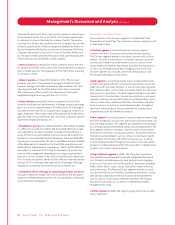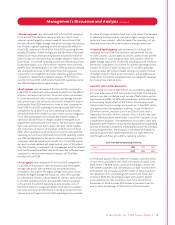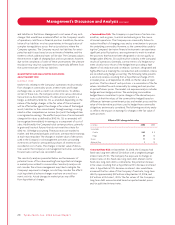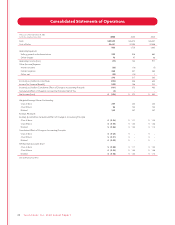Tyson Foods 2006 Annual Report Download - page 23
Download and view the complete annual report
Please find page 23 of the 2006 Tyson Foods annual report below. You can navigate through the pages in the report by either clicking on the pages listed below, or by using the keyword search tool below to find specific information within the annual report.
At September 30, 2006, the Company had variable rate, long-term
debt of $545 million with a weighted average interest rate (as of
September 30, 2006) of 6.1%. The Company hedges exposure to
changes in interest rates on certain financial instruments. Under the
terms of various leveraged equipment loans, the Company enters
into interest rate swap agreements to effectively lock in a fixed
interest rate for these borrowings. The maturity dates of these lever-
aged equipment loans range from fiscal years 2007 to 2009 with
interest rates ranging from 4.7% to 5.4%. Because of the positions
taken with respect to these swap agreements, an increase in inter-
est rates would have a minimal effect on interest expense for fiscal
years 2006 and 2005.
• Foreign Currency Risk: The Company has non-cash foreign
exchange gain/loss exposure from fluctuations in foreign cur-
rency exchange rates as a result of certain receivables and payable
balances. The primary currency exchanges the Company has expo-
sure to are the Canadian dollar, the Mexican peso, the European
euro, the British pound sterling and the Brazilian real. The Company
periodically enters into foreign exchange forward contracts to
hedge some of its foreign currency exposure. A hypothetical 10%
change in foreign exchange rates amounts to approximately $4 mil-
lion at September 30, 2006, and $5 million at October 1, 2005.
• Concentrations of Credit Risk: The Company’s financial instruments
exposed to concentrations of credit risk consist primarily of cash
equivalents, short-term investments and trade receivables. The
Company’s cash equivalents and short-term investments are in high
quality securities placed with major banks and financial institutions.
Concentrations of credit risk with respect to receivables are limited
due to the large number of customers and their dispersion across
geographic areas. The Company performs periodic credit evaluations
of its customers’ financial condition and generally does not require
collateral. At September 30, 2006, and October 1, 2005, approximately
13.0% of the Company’s net accounts receivable balance was due from
one customer. No other single customer or customer group represents
greater than 10% of net accounts receivable.
CAUTIONARY STATEMENTS RELEVANT TO FORWARD-LOOKING
INFORMATION FOR THE PURPOSE OF “SAFE HARBOR” PROVISIONS
OF THE PRIVATE SECURITIES LITIGATION REFORM ACT OF 1995
Certain information in this report constitutes forward-looking
statements. Such forward-looking statements include, but are not
limited to, current views and estimates of future economic circum-
stances, industry conditions in domestic and international markets,
Company performance and financial results, including, without
limitation, debt-levels, return on invested capital, value-added
product growth, capital expenditures, tax rates, access to foreign
markets and dividend policy. These forward-looking statements are
subject to a number of factors and uncertainties that could cause
the Company’s actual results and experiences to differ materially
from the anticipated results and expectations expressed in such
forward-looking statements. The Company wishes to caution readers
not to place undue reliance on any forward-looking statements,
which speak only as of the date made. Tyson undertakes no obliga-
tion to publicly update any forward-looking statements, whether
as a result of new information, future events or otherwise.
Among the factors that may cause actual results and experiences
to differ from the anticipated results and expectations expressed in
such forward-looking statements are the following: (i) fluctuations
in the cost and availability of inputs and raw materials, such as live
cattle, live swine, feed grains (including corn and soybean meal) and
energy; (ii) the Company’s ability to realize anticipated savings from
its cost reduction initiatives; (iii) market conditions for finished
products, including competition from other global and domestic
food processors, the supply and pricing of competing products
and alternative proteins and the demand for alternative proteins;
(iv) risks associated with effectively evaluating derivatives and
hedging activities; (v) access to foreign markets together with
foreign economic conditions, including currency fluctuations,
import/export restrictions and foreign politics; (vi) outbreak of a
livestock disease (such as avian influenza (AI) or bovine spongiform
encephalopathy (BSE)), which could have an effect on livestock
owned by the Company, the availability of livestock for purchase by
the Company, consumer perception of certain protein products or
the Company’s ability to access certain domestic and foreign
markets; (vii) successful rationalization of existing facilities, and the
operating efficiencies of the facilities; (viii) changes in the availabil-
ity and relative costs of labor and contract growers and the ability
of the Company to maintain good relationships with employees,
labor unions, contract growers and independent producers provid-
ing livestock to the Company; (ix) issues related to food safety,
including costs resulting from product recalls, regulatory compli-
ance and any related claims or litigation; (x) changes in consumer
preference and diets and the Company’s ability to identify and
react to consumer trends; (xi) significant marketing plan changes
by large customers or the loss of one or more large customers;
(xii) adverse results from litigation; (xiii) risks associated with lever-
age, including cost increases due to rising interest rates or changes
in debt ratings or outlook; (xiv) changes in regulations and laws
(both domestic and foreign), including changes in accounting stan-
dards, tax laws, environmental laws and occupational, health and
safety laws; (xv) the ability of the Company to make effective
acquisitions and successfully integrate newly acquired businesses
into existing operations; (xvi) effectiveness of advertising and
marketing programs; (xvii) the effect of, or changes in, general
economic conditions; and (xviii) those factors listed under Item 1A,
“Risk Factors” included in the Company’s September 30, 2006, Annual
Report filed on Form 10-K.
Ty s o n F o o d s , I n c . 2 0 0 6 A n n u a l R e p o r t 21
Management’s Discussion and Analysis continued
























